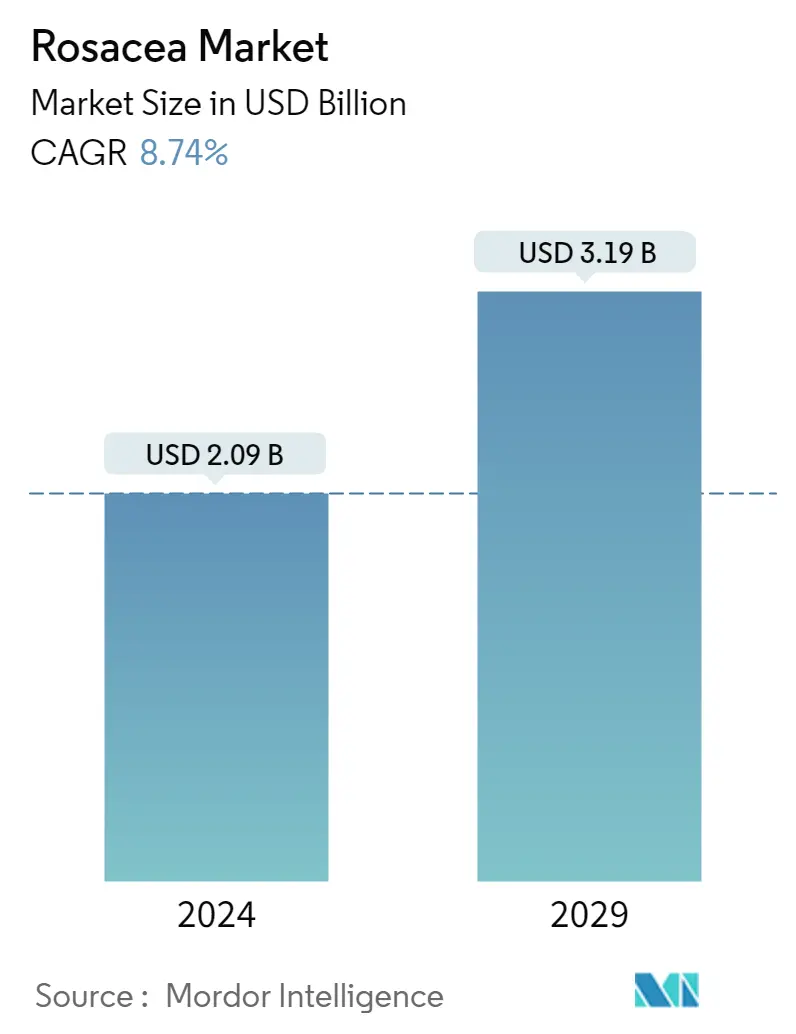Market Size of Rosacea Industry

| Study Period | 2019 - 2029 |
| Market Size (2024) | USD 2.09 Billion |
| Market Size (2029) | USD 3.19 Billion |
| CAGR (2024 - 2029) | 8.74 % |
| Fastest Growing Market | Asia Pacific |
| Largest Market | North America |
| Market Concentration | Medium |
Major Players
*Disclaimer: Major Players sorted in no particular order |
Rosacea Market Analysis
The Rosacea Market size is estimated at USD 2.09 billion in 2024, and is expected to reach USD 3.19 billion by 2029, growing at a CAGR of 8.74% during the forecast period (2024-2029).
COVID-19 had a significant impact on the growth of the market during the pandemic period. This is mainly due to the worsening of the rosacea condition due to the COVID-19 protection kits.
For instance, according to the article published in February 2021, a survey conducted by Galderma suggested that the pandemic may impact rosacea patients by worsening of signs and symptoms related to mask-wearing, and there were reduced healthcare professional consultations. Thus, the demand for rosacea treatment due to the COVID-19 outbreak contributed to the market's growth during the pandemic period. However, the pandemic has subsided, so the studied market is expected to grow generally during the forecast period.
The growth of the market is attributed to factors such as the increasing prevalence of rosacea among the global population. For instance, the article published by the International Journal of Dermatology in December 2021 mentioned that 2.1% of the survey participants had rosacea. The prevalence of rosacea increased significantly with age. The report also mentioned that Rosacea is a common skin condition most prevalent above the age of 65.
Moreover, according to World Health Organization (WHO) data published in October 2021, it is estimated that 1 in 6 people worldwide will be aged 60 years or over, in seven years. The share of the population aged 60 years and over will increase to 1.4 billion. The world's population of people aged 60 years and older will double (2.1 billion) in 27 years. The number of persons aged 80 or older is expected to triple in 27 years to reach 426 million. Thus, the rising geriatric population worldwide is also expected to boost the growth of the rosacea treatment market.
Moreover, the rising developments by major market players are also expected to boost market growth. For instance, in June 2021, Sol-Gel Technologies and Galderma announced the signing of two exclusive five-year license agreements for the commercialisation of Epsolay and Twyneo in the United States.
Therefore, with rising prevalence, the awareness among physicians and societies has also increased, further driving the demand for this market. However, the presence of generic drugs to curb the related symptoms hinders the growth of the rosacea market.
Rosacea Industry Segmentation
As per the scope of the market, rosacea is a condition diagnosed by symptoms, such as facial flushing, coarseness of the skin, and an inflammatory papulopustular eruption resembling acne. The rosacea market is segmented by drug class (antibiotics, alpha agonists, retinoids, corticosteroids, immunosuppressants, and other drug classes), mode of administration (topical and oral), and geography (North America, Europe, Asia-Pacific, Middle East and Africa, and South America). The market report also covers the estimated market sizes and trends for 17 different countries across major regions globally. The report offers the value (in USD) for the above segments.
| By Drug Class | |
| Antibiotics | |
| Alpha Agonists | |
| Retinoid | |
| Corticosteroids | |
| Immunosuppressants | |
| Other Drug Classes |
| By Mode of Administration | |
| Topical | |
| Oral |
| Geography | ||||||||
| ||||||||
| ||||||||
| ||||||||
| ||||||||
|
Rosacea Market Size Summary
The rosacea market is poised for significant growth over the forecast period, driven by an increasing prevalence of the condition globally, particularly among the aging population. The market's expansion is supported by the rising awareness and understanding of rosacea among healthcare professionals and the public, as well as advancements in treatment options. The demand for effective treatments, including antibiotics, is bolstered by the high efficacy of these medications in managing rosacea symptoms. The market's growth trajectory is further enhanced by strategic developments and partnerships among key industry players, which are focused on introducing innovative products and expanding their market presence.
North America stands out as a key region for the rosacea market, attributed to high healthcare expenditure, robust awareness campaigns, and favorable regulatory environments that encourage the launch of new products. The region's market is characterized by significant competition among leading companies, which are actively engaged in research and development to enhance treatment offerings. The presence of major players and their strategic initiatives contribute to the market's dynamic nature, ensuring a steady growth trajectory. Despite the challenges posed by generic alternatives, the market's potential remains strong, driven by the ongoing demand for effective rosacea treatments and the increasing geriatric population.
Rosacea Market Size - Table of Contents
-
1. MARKET DYNAMICS
-
1.1 Market Overview
-
1.2 Market Drivers
-
1.2.1 Increasing Incidence and Prevalence of Rosacea
-
1.2.2 Increasing Inclination Toward Combination Products
-
-
1.3 Market Restraints
-
1.3.1 Increased Use of Generic Drugs
-
-
1.4 Porter's Five Forces Analysis
-
1.4.1 Bargaining Power of Suppliers
-
1.4.2 Bargaining Power of Buyers/Consumers
-
1.4.3 Threat of New Entrants
-
1.4.4 Threat of Substitute Products
-
1.4.5 Intensity of Competitive Rivalry
-
-
-
2. MARKET SEGMENTATION (Market Size by Value - USD)
-
2.1 By Drug Class
-
2.1.1 Antibiotics
-
2.1.2 Alpha Agonists
-
2.1.3 Retinoid
-
2.1.4 Corticosteroids
-
2.1.5 Immunosuppressants
-
2.1.6 Other Drug Classes
-
-
2.2 By Mode of Administration
-
2.2.1 Topical
-
2.2.2 Oral
-
-
2.3 Geography
-
2.3.1 North America
-
2.3.1.1 United States
-
2.3.1.2 Canada
-
2.3.1.3 Mexico
-
-
2.3.2 Europe
-
2.3.2.1 Germany
-
2.3.2.2 United Kingdom
-
2.3.2.3 France
-
2.3.2.4 Italy
-
2.3.2.5 Spain
-
2.3.2.6 Rest of Europe
-
-
2.3.3 Asia-Pacific
-
2.3.3.1 China
-
2.3.3.2 Japan
-
2.3.3.3 India
-
2.3.3.4 Australia
-
2.3.3.5 South Korea
-
2.3.3.6 Rest of Asia-Pacific
-
-
2.3.4 Middle East and Africa
-
2.3.4.1 GCC
-
2.3.4.2 South Africa
-
2.3.4.3 Rest of Middle East and Africa
-
-
2.3.5 South America
-
2.3.5.1 Brazil
-
2.3.5.2 Argentina
-
2.3.5.3 Rest of South America
-
-
-
Rosacea Market Size FAQs
How big is the Rosacea Market?
The Rosacea Market size is expected to reach USD 2.09 billion in 2024 and grow at a CAGR of 8.74% to reach USD 3.19 billion by 2029.
What is the current Rosacea Market size?
In 2024, the Rosacea Market size is expected to reach USD 2.09 billion.

